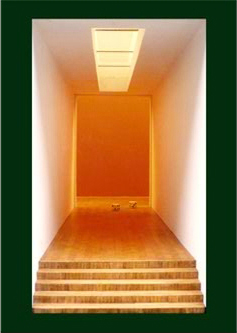RPProjects: Revisiting the triptych at Museum van Nagsael, Rotterdam (2006)
Sometimes things work out like a celebratory press release, and sometimes they aren’t actually that way at all.
Art Design Publicity at ADC | 5 October 2011
This essay was previously published in Museum van Nagsael: 11 years, 132 exhibitions (Veenman: Rotterdam), p. 258 in 2006.
-

Jacqueline Pennell art: Aleatoric, (front view) (2002). Installed at Museum van Nagsael, Rotterdam.
It started out innocently enough. A three-part project [April * June * August 2002], somehow, in response— just six months after all hell broke loose, when the New York towers were violently penetrated. The burning, the shocking collapse— times 2. And that ghostly dust— slowly moving down the streets of 20th century capitalism— and so unnervingly covered by CNN. Thinking, with an event like this, what on earth does the future hold?
With this in mind, the three-part project was developed, conceived as an early 21st century triptych— with an almost timeless topic— Bosch’s The garden of earthly delights— appropriate to the location, with depictions of Eden, Hell, and the Delights. Three artworks by three contemporary artists would be presented, aligned to the triptych panels, and might provide answers to some difficult questions.
Interweaved in this, there were ideas about "media coverage maximisation" within a visual art context— merged with the "Museum"— and the beauty of press release creation and distribution. And verbal strategies would be fused with clear and seductive imagery. The goal? To activate late British Sensation— remotely, across the Channel, delivered largely via the Internet, based upon the organiser’s truly excessive amount of arts media research, which would act as an integrated vehicle to tell the story.
At least, this was... the intention...
What resulted with the first installation was rather different, perhaps very much like the original Fall. Instead of projecting this panel in a verbal-visual fusion to the outside world, the fall ended up being a rather intense artist-and-organiser role play. For two months, I was unexpectedly trapped inside the Museum’s Hell, with the endless fall as a reminder on video loop, as I eagerly welcomed [desperately,] the next installation.
As a piece, this second installation, Jacqueline Pennell’s Aleatoric, artistically aligned itself to Hell. This work projected uncertainty with a simple, yet ingeniously placed hall of mirrors, visible via the Museum’s peephole. This contrasted with the front view, showing simple dice and the colour of menacing, abstract heat. Yet while the artistic goal had been achieved, ironically for this organiser, it actually symbolised Eden— that is, before the bite— with its smoothly aligned organisational process. (See the press release.)
By the time Jeremy Wood entered the Museum with the third installation, Paradise, the Project now reached its fifth month. I was now exhausted with the effect of the fall, while the patient co-director Silvia B, the patron of the triptych, looked on. Upon agreement, it was decided that no release for Paradise would be issued.
It therefore seemed appropriate to retreat— and go back to "Art". On a simple turntable, a spinning 2-D image of a Delights detail rotated perfectly— like the Earth. Watching from outside, no matter what we did, the Art was there and the world kept spinning— whether we chose to enter the Gardens of Eden or Delights, or not.
And for the organiser at least, the questions laid out for the project, had been answered.